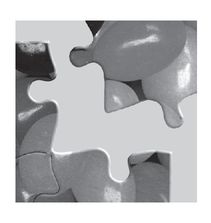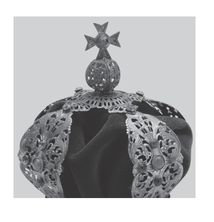Firsts (14 page)
Authors: Wilson Casey

Immigrant to Pass Through Ellis Island
 Instant Camera
Instant Camera
 Jukebox
Jukebox

On January 1, 1892, Ellis Island officially opened, and on that day, an Irish girl named Annie Moore was the first registered passenger to pass through the immigration station. It was her birthday, too. She had just turned 15 and was presented with $10 for being the first person through the new station. Miss Moore was traveling with her two younger brothers, Anthony (11) and Phillip (7). They had departed from Queenstown, Ireland, on December 20, 1891, aboard the SS
Nevada,
spent 12 days at sea, and arrived in New York on New Year’s Eve. Soon all three Moore children were reunited with their parents, who were already living in New York.
Income TaxNevada,
spent 12 days at sea, and arrived in New York on New Year’s Eve. Soon all three Moore children were reunited with their parents, who were already living in New York.
In 1427, the first income tax was called the
catasto
and was instituted by the Commune of Florence, Italy, for all the domains under Florentine rule. Proposed by Giovanni di Bicci de’ Medici, a leader of the time, the tax was designed to bring about a more equal distribution of taxation. Each household was required to file a declaration of all assets, credits, and debts along with a list of its members. The information was used to calculate a taxable amount that was to be paid yearly.
Indoor Skating Rinkcatasto
and was instituted by the Commune of Florence, Italy, for all the domains under Florentine rule. Proposed by Giovanni di Bicci de’ Medici, a leader of the time, the tax was designed to bring about a more equal distribution of taxation. Each household was required to file a declaration of all assets, credits, and debts along with a list of its members. The information was used to calculate a taxable amount that was to be paid yearly.
In 1862, the Victoria Skating Rink, the first indoor skating rink of notable record, opened in Montreal, Canada, as an ice rink. During the winter months, it was used for pleasure skating, ice hockey, and skating sports. During the summer, the ice was thawed and the building was used for musical performances and horticultural shows. The facility was a long, two-story brick building with a high-pitched roof supported from within by curving wooden trusses. Tall, round-arched windows ran the length of the building and illuminated the interior. Evening skating was made possible by 500 gas-jet lighting fixtures set in colored glass globes. Later in the rink’s history, the lighting was converted to electric, making it the first building in Canada to be electrified. Another first for the Victoria: it housed the first indoor hockey game.
Indoor ToiletKing Minos of Crete had the first flushing water closet recorded in history more than 2,800 years ago … and that’s about all that’s known about it. Later, a crude toilet was discovered in the tomb of a Chinese king of the Western Han dynasty dating to anywhere from 206 B.C.E. to 24 C.E. Chamber pots, metal or ceramic bowls used and then emptied of the contents (many times out the window!), were used during the Middle Ages. In 1594, Sir John Harrington built a “prive in perfection” (flush toilet) for his godmother, Queen Elizabeth I of England. But it wasn’t until 1775 that the first patent for the flushing toilet was issued to British watchmaker Alexander Cummings. With Cummings’s design, the forerunner of the modern toilet, some water remained in the bowl after each flush.
Influenza Epidemic1580 marked the first recorded widespread outbreak of the influenza virus as it swept across Asia Minor, northern Africa, and Europe, resulting in millions of deaths. The word
influenza
was derived from the Latin word
influentia.
Sixteenth-century Italians first applied the word
influenza
to outbreaks of any epidemic disease because they blamed such events on the influence of heavenly bodies. The 1580 flu outbreak was so wide-ranging that it was later labeled a pandemic, which is an epidemic over an extremely large area.
Inoculationinfluenza
was derived from the Latin word
influentia.
Sixteenth-century Italians first applied the word
influenza
to outbreaks of any epidemic disease because they blamed such events on the influence of heavenly bodies. The 1580 flu outbreak was so wide-ranging that it was later labeled a pandemic, which is an epidemic over an extremely large area.
Although debatable, the earliest record of inoculation was found and practiced in eighth-century India for smallpox. Indian physician Madhav compiled a 79-chapter book called the
Nidna
that listed diseases along with their causes, symptoms, and complications. Within the book, he included a special chapter on smallpox (
masrik
) that described a method of inoculation to protect against the disease. Treatment was done by pricking the skin of the patient’s arm with a small metal instrument to inoculate with year-old smallpox matter that had been gathered from infected victims. The inoculators traveled all across India to administer the procedure.
Nidna
that listed diseases along with their causes, symptoms, and complications. Within the book, he included a special chapter on smallpox (
masrik
) that described a method of inoculation to protect against the disease. Treatment was done by pricking the skin of the patient’s arm with a small metal instrument to inoculate with year-old smallpox matter that had been gathered from infected victims. The inoculators traveled all across India to administer the procedure.

On February 21, 1947, the Land Camera was the first commercial instant camera to be used. It had self-developing film and was invented by American scientist Edwin Herbert Land, founder of the Polaroid Corporation. The camera’s specially prepared photographic paper had pods of developer and a fixing agent sandwiched with the film. After the snapshot was taken, the photographer turned a camera knob that squeezed open one of the pods to develop the negative and make the print. The completed picture was made in about 1 minute. The camera was a hit.
Instant CoffeeThe earliest, but unsubstantiated, version of instant coffee is said to have appeared around 1771 in Britain. In 1901, the first successful technique for manufacturing a stable powdered product was invented by Japanese American chemist Satori Kato of Chicago. His just-add-hot-water “instant” coffee used a process he had developed for making instant tea. In 1906, English chemist George Constant Washington invented the first mass-produced instant coffee. Living in Guatemala at the time, Washington created and marketed “Red E Coffee” brand instant coffee in 1909. In 1938, Nescafé invented its freeze-dried coffee.
Instant CreamerIn 1961, Glendale, California’s Nestlé company produced Coffee-Mate, the first powdered nondairy instant creamer. Coffee-Mate needed no refrigeration, and half a spoonful or more could be added to black coffee to whiten it and alter the coffee’s taste. Before this time, coffee drinkers had to add real dairy cream or milk. Coffee-Mate contained a milk derivative with no lactose, corn syrup, or vegetable oil solids.
Instant ReplayIn 1955, the Canadian Broadcasting Corporation (CBC), headquartered in Ottawa, Ontario, invented the first form of instant replay. It occurred when director George Retzlaff produced the first in-game replays that he used on
Hockey Night in Canada,
a sports show broadcast on Saturday evenings. Thanks to the instant replay, Retzlaff was able to show clips of scored goals within 30 seconds of the goal being made. He did this by employing a kinescope (the motion-picture record or film of a television program) that could be developed and replayed quickly, picking out the desired parts or action.
InsuranceHockey Night in Canada,
a sports show broadcast on Saturday evenings. Thanks to the instant replay, Retzlaff was able to show clips of scored goals within 30 seconds of the goal being made. He did this by employing a kinescope (the motion-picture record or film of a television program) that could be developed and replayed quickly, picking out the desired parts or action.
Around 2000 B.C.E., the Babylonian traders practiced the first insurance, or early method of transferring or distributing risk. They were encouraged to assume the risks of the caravan trade through loans that were repaid with interest only after their goods had arrived safely at their destinations. If a merchant received a loan to fund his shipment, he would pay the lender an additional sum in exchange for the lender’s guarantee to cancel the loan should the shipment be stolen or lost at sea. This procedure was given legal force in the Code of Hammurabi, a collection of the laws and edicts of the Babylonian king.
Intensive Care UnitIn 1854, the first intensive care unit (ICU) was the Monitoring Unit of critically wounded patients attended to under nurse Florence Nightingale’s guidance. These units were in the British hospitals located in Constantinople (now Istanbul, Turkey) during the Crimean War. Nightingale led more than three dozen nurses to section off the gravest of patients for more attentive care; before this, the mortality rate of hospitalized soldiers was as high as 40 percent. Nightingale instigated a “critical care protocol” of separating patients by severity of injuries and illnesses so they could receive more medical care. This practice made the mortality rate fall to 2 percent and paved the way for future ICUs.
Internet DomainOn March 15, 1985,
Symbolics.com
became the first registered Internet domain. Researchers at the University of Wisconsin had just introduced the Internet domain name system (DNS) with ordinary words as names in 1984. With the name server, users were no longer required to remember lengthy numbers to know the exact path to other systems. From their connected computers, users could type in a name or series of letters to get to a website. Symbolics, a computer manufacturing company, was bankrupt by the early 1990s, but the first registered Internet domain lives on with new owners.
Interstate HighwaySymbolics.com
became the first registered Internet domain. Researchers at the University of Wisconsin had just introduced the Internet domain name system (DNS) with ordinary words as names in 1984. With the name server, users were no longer required to remember lengthy numbers to know the exact path to other systems. From their connected computers, users could type in a name or series of letters to get to a website. Symbolics, a computer manufacturing company, was bankrupt by the early 1990s, but the first registered Internet domain lives on with new owners.
Commissioned on March 29, 1806, the National Road was the first federally financed interstate. Running from Cumberland, Maryland, through Pennsylvania, West Virginia, Ohio, and Indiana, to Vandalia, Illinois, it took decades to finish. The approximate 700 miles of what was initially little more than a dirt road helped open the land west of the Appalachians to settlers and commerce. Later paved and lengthened to span its 824-mile route, the National Road eventually evolved into US 40. It was the first official road linking multiple states.
J
JetIn October 1910, the Coanda-1910 made its first and only flight. It was the world’s first air reactive (jet) airplane, invented by Henri Coanda of Bucharest, Romania. The jet had no propeller, and its wings were made with steel leading edges instead of wood. The gasoline engine’s layout was the real innovation: it was housed under a cowl and through a gearbox, and turned a compressor at 4,000 rotations per minute. The engine’s combustion-thrust was much greater than that of a normal gasoline engine and propeller. It was created by mixing the compressor’s exhaust, the gasoline engine’s exhaust, and additional fuel. This mixture was ported into two ring-shape burning chambers located on each side of the fuselage.
Jigsaw PuzzleAround 1760, John Spilsbury, a London engraver and mapmaker, introduced the first jigsaw puzzle in England. The puzzle was a map of England and surrounding countries. Each piece of the puzzle was a separate country. There were no interlocking pieces, but rather the pieces simply butted up to each other. To produce the puzzle, Spilsbury glued one of his maps to a thin sheet of hardwood. He then cut out around the national boundaries using a fine-bladed saw. For the finishing touches, he added some hand painting and applied a veneer finish. The end product was soon used as an educational aid to teach geography to British children in a fun way.

On November 23, 1889, the forerunner to the modern jukebox was the Nickel-in-the-Slot machine, a coin-operated phonograph player placed in the Palais Royale Saloon in San Francisco, California, by Louis Glass and William Arnold. This first jukebox was a modified Edison Class M electric phonograph. It was housed in an oak cabinet refitted with a coin mechanism patented by Glass and Arnold. There was no amplification, and patrons had to listen to whatever music was on the queue using one of four listening tubes. The device was highly successful and earned more than $1,000 in its first 6 months.
K
KingAround 2333 B.C.E., Tangun Wanggom established the first acknowledged kingdom in what is now Korea and served as both king and shaman. (
Tangun
means “god of the earth,”
wang
means “king,” and
gom
represents “priest” or “shaman.”) The world’s first king was an enterprising ruler who was loved and seemingly worshipped by his followers. Tangun called his land Choson and is credited with inaugurating a national religion and establishing a national capital at Asadal (now Pyongyang, North Korea). Although some dismiss King Tangun as only a legend, Chinese records written 20 to 30 centuries before Christ do mention the land of Choson.
Tangun
means “god of the earth,”
wang
means “king,” and
gom
represents “priest” or “shaman.”) The world’s first king was an enterprising ruler who was loved and seemingly worshipped by his followers. Tangun called his land Choson and is credited with inaugurating a national religion and establishing a national capital at Asadal (now Pyongyang, North Korea). Although some dismiss King Tangun as only a legend, Chinese records written 20 to 30 centuries before Christ do mention the land of Choson.

Other books
Love's Rescue by Christine Johnson
Kill Them Wherever You Find Them by David Hunter
Salida hacia La Tierra by George H. White
Only Yesterday by S. Y. Agnon
The November Criminals by Sam Munson
The Lost Prince by Julie Kagawa
The Jackal of Nar by John Marco
The Crepes of Wrath by Tamar Myers
Triumph and Tragedy (The Second World War) by Winston S. Churchill
Ghosting by Edith Pattou
